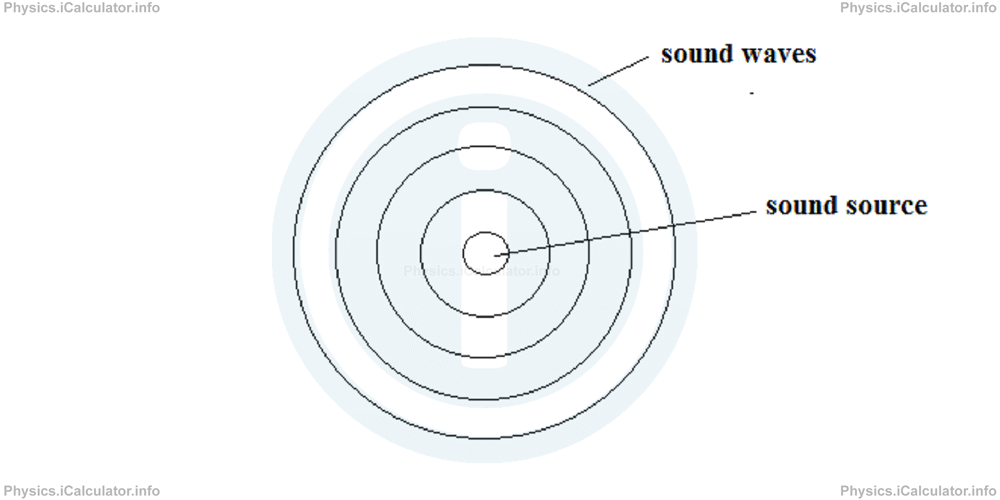Menu
Physics Lesson 11.5.5 - Intensity of Sound Waves
Please provide a rating, it takes seconds and helps us to keep this resource free for all to use
Welcome to our Physics lesson on Intensity of Sound Waves, this is the fifth lesson of our suite of physics lessons covering the topic of Sound Waves. Intensity and Sound Level, you can find links to the other lessons within this tutorial and access additional physics learning resources below this lesson.
Intensity of Sound Waves
Sound waves propagate in all directions like an enlarging sphere. However, the power of sound decreases when moving away from the source as the virtual sphere becomes larger and as a result, the same sound has to propagate in a larger area. This means less sound per unit area falls on a listener or receiver who obviously has a constant area of his/her ear or sound detector. We saw "the sound has a lower intensity when moving away from the source".

Thus, by definition, sound intensity is the power of sound in the unit of area. Given that the area involved is that of a sphere, we obtain for the sound intensity:
= P/4π × r2
where r is the distance from the source to the receiver, i.e. the radius of the sphere.
The unit of sound intensity is [W/m2] as power is measured in watts and area in square metres.
Example 2
A sound source emits waves of energy equal to 0.05 J every second. What is the sound intensity 10 m away from the source?Solution 2
In this problem, we have the following clues:
E = 0.05 J
t = 1 s
r = 10 m
I = ?
First, let's work out the sound power. We have
= 0.05 J/1 s
= 0.05 W
Thus, for the sound intensity at 10 m away from source, we obtain
= P/4π × r2
= 0.05/4 × 3.14 × 102
= 3.98 × 10^(-5) W/m2
As you can see from the result, the intensity of sound at 10 m away from the source is very small as sound waves do not carry much energy and therefore, they have a small power. Furthermore, the large distance contributes in a further decrease in the sound intensity as less sound falls in the unit of area.
The lowest intensity representing the faintest sound a human ear can detect is about 10-12 W/m2. This minimum intensity is denoted by I0 and it is known as the "threshold of hearing". The value obtained in the above example for the intensity of sound (3.98 × 10-5 W/m2) is considered as large for humans hearing, so it may be disturbing for people who are subjected to it.
You have reached the end of Physics lesson 11.5.5 Intensity of Sound Waves. There are 7 lessons in this physics tutorial covering Sound Waves. Intensity and Sound Level, you can access all the lessons from this tutorial below.
More Sound Waves. Intensity and Sound Level Lessons and Learning Resources
Whats next?
Enjoy the "Intensity of Sound Waves" physics lesson? People who liked the "Sound Waves. Intensity and Sound Level lesson found the following resources useful:
- Intensity Feedback. Helps other - Leave a rating for this intensity (see below)
- Waves Physics tutorial: Sound Waves. Intensity and Sound Level. Read the Sound Waves. Intensity and Sound Level physics tutorial and build your physics knowledge of Waves
- Waves Revision Notes: Sound Waves. Intensity and Sound Level. Print the notes so you can revise the key points covered in the physics tutorial for Sound Waves. Intensity and Sound Level
- Waves Practice Questions: Sound Waves. Intensity and Sound Level. Test and improve your knowledge of Sound Waves. Intensity and Sound Level with example questins and answers
- Check your calculations for Waves questions with our excellent Waves calculators which contain full equations and calculations clearly displayed line by line. See the Waves Calculators by iCalculator™ below.
- Continuing learning waves - read our next physics tutorial: Electromagnetic Waves. Light
Help others Learning Physics just like you
Please provide a rating, it takes seconds and helps us to keep this resource free for all to use
We hope you found this Physics lesson "Sound Waves. Intensity and Sound Level" useful. If you did it would be great if you could spare the time to rate this physics lesson (simply click on the number of stars that match your assessment of this physics learning aide) and/or share on social media, this helps us identify popular tutorials and calculators and expand our free learning resources to support our users around the world have free access to expand their knowledge of physics and other disciplines.